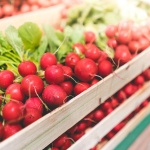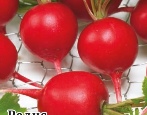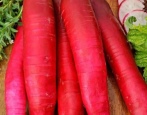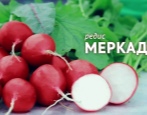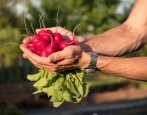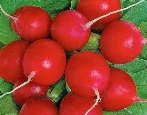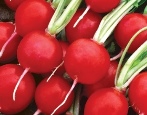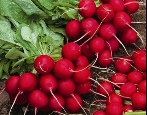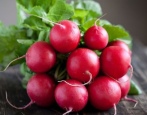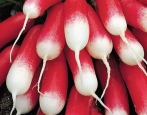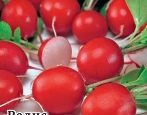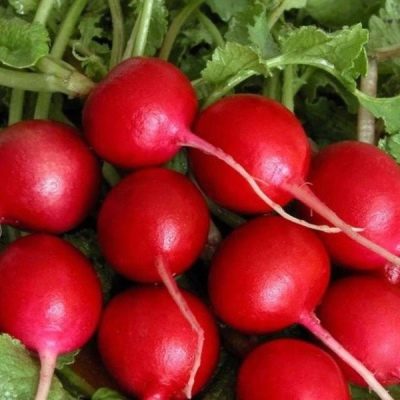
- Year of approval: 1956
- Ripening terms: early
- Leaves: green
- The form: rounded
- Coloration: red-crimson
- Weight, g: 18-27
- Color of the pulp: white and white-pink
- Pulp (consistency): dense, juicy
- Taste qualities: good ones
- Average yield: 2.5-2.8 kg / m2
Radish of the Zhara variety is one of the oldest among those grown in Russia; it is popular with farmers and summer residents due to its early maturity, pleasant taste, and general unpretentiousness of the plant. Vegetable culture is well adapted to changing weather, temperature extremes. Grown in most farming areas.
Breeding history
The variety was registered in 1956 at the request of the Lithuanian Research Institute of Fruit and Vegetable Economy. It was brought out at the Vitenskaya experimental station. Michurin. Focused on growing in horticultural culture. Among the modern originators one can distinguish LLC "Agrofirma Poisk" and LLC "Agrofirma Aelita".
Description of the variety
Heat is a high-yielding variety for outdoor cultivation. Forms a spreading, low-leafed rosette. Differs in high marketability, but not suitable for long-term storage. Transfers transportation normally. Contains significant amounts of vitamin C.
Characteristics of the appearance of the plant and root crops
This radish variety has green leaves, tops are not too large, compact. Painted in light colors. When grown properly, too many leaves are not produced.
Root crops are rounded, with a smooth skin, painted in a red-raspberry color on the outside, and white or slightly pinkish on the inside. The weight of each varies in the range of 18-27 grams. The diameter and length of the root crop are almost equal, on average about 4 cm.
Purpose and taste of tubers
Radish Heat is ideal for fresh consumption, in salads and with sauces. Taste qualities are assessed as good, with pleasant mild notes. The consistency of the pulp is dense and juicy.
Maturation
The variety is early, characterized by amicable ripening. It takes 3-3.5 weeks from germination to harvest.
Yield
The average collection rates are 2.5-2.8 kg of fruits per 1 m2.
Growing regions
The variety is successfully cultivated in most regions of the Russian Federation. It is suitable for sowing directly into the ground in the central and chernozem areas, in the Urals and Siberia.
Growing and care
For sowing Radish Heat, it is recommended to choose a sunny place, most of the day in the light. The optimal planting scheme for this variety is 10 × 5 cm. The primary sowing is carried out from April 20 to June 15. To obtain the second harvest, choose the 2nd decade of August. Seedlings will appear in 5-7 days.
Radish of this variety needs quite intense moisture. Irrigation frequency is regulated by weather conditions. During periods of extreme heat, watering is carried out daily. The variety is sensitive to fertilizing, the first fertilizers are applied even when digging the soil, a mineral complex or natural compost is suitable.
In the aisles, it is recommended to periodically loosen the soil. In the summer heat of planting, it is better to lightly shade with white agrofibre. During the ripening period, you should be prepared for the top of the root crops to be above the ground. In this case, you do not need to spud the plants.
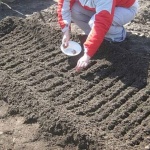

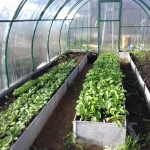
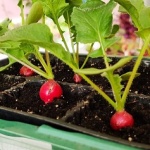
Soil requirements
For sowing seeds, loose, light earth is best suited, which is well permeable to air and water. Loam or sandy loam with a fertile structure is suitable. Acidified soils should be avoided.
Required climatic conditions
The variety is cold-resistant. Even a significant drop in atmospheric temperatures is tolerated well. Adapted to heat.
Disease and pest resistance
Radish Heat is resistant to stalking, well protected from major diseases, does not attract pests. Problems can arise when sowing seeds after other cruciferous crops. In this case, the plants are attacked by fleas. If there is a bear in the garden, you should take care of its destruction by chemical means or folk methods.

Review overview
Over the long years of the existence of the Zhara variety, this radish managed to get a lot of reviews from ordinary summer residents and amateur vegetable growers. Among its positive qualities, a pleasant taste without bitterness is noted, indeed, rapid ripening, trouble-free growth in any weather. Seed material is also praised for its high germination rates, close to 100%.
It is noted that the variety demonstrates the best yield in early spring and autumn, when daylight hours are not so great and average temperatures are close to optimal. The purchase of seeds does not make a hole in the budget, according to the reviews of summer residents, the average cost of a package does not exceed 15 rubles. There are no problems with determining the ripeness of the crop either, it ripens right on time. Summer residents praise root crops for the crunch and juiciness of the pulp, ease of cutting, resistance to rot and deformation.
There are also disadvantages, but insignificant. So, the plant has some problems with the burning out of the tops in the heat. In taste, some summer residents find excessive pungency, the size may also seem not large enough. It is noted that in many characteristics the Heat is already significantly inferior to newer varieties of radish, both domestic and Dutch selection.
